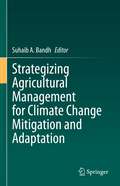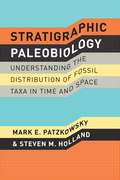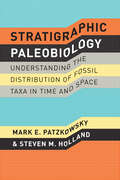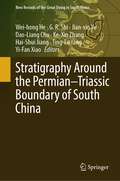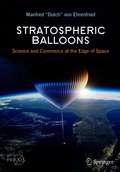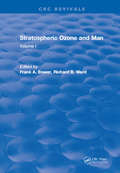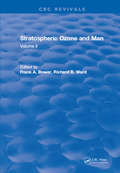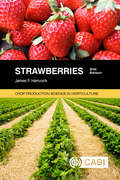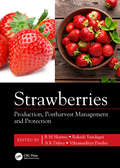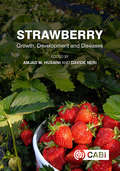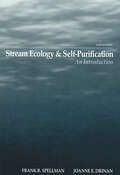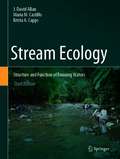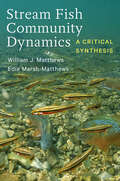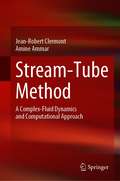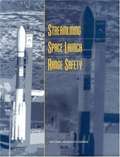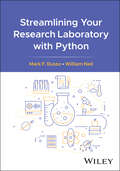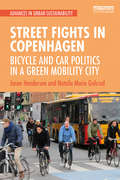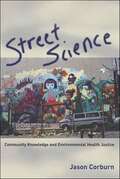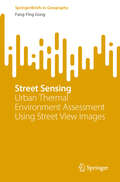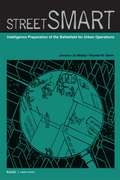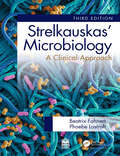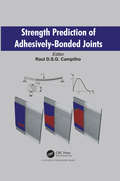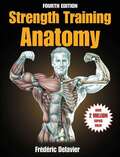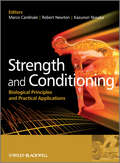- Table View
- List View
Strategizing Agricultural Management for Climate Change Mitigation and Adaptation
by Suhaib A. BandhThis volume aims to raise awareness and stimulate research on how agricultural management could help to mitigate climate change impacts, and focuses on technical progressions and innovations in climate change mitigation and adaptation. It addresses new innovations in agricultural technology and management with the goal of balancing agricultural production and its associated climate effects in a sustainable manner. The major topics covered include crop and soil management, techniques and technologies for emission reduction, irrigation, land degradation, pest and disease management, farmers' perspectives, and climate-smart agriculture policy. The book is geared towards students, researchers, and professionals in the fields of environmental science, agriculture science, and climate change.
Stratigraphic Paleobiology: Understanding the Distribution of Fossil Taxa in Time and Space
by Mark E. Patzkowsky Steven M. HollandWhether the fossil record should be read at face value or whether it presents a distorted view of the history of life is an argument seemingly as old as many fossils themselves. In the late 1700s, Georges Cuvier argued for a literal interpretation, but in the early 1800s, Charles Lyell's gradualist view of the earth's history required a more nuanced interpretation of that same record. To this day, the tension between literal and interpretive readings lies at the heart of paleontological research, influencing the way scientists view extinction patterns and their causes, ecosystem persistence and turnover, and the pattern of morphologic change and mode of speciation. With Stratigraphic Paleobiology, Mark E. Patzkowsky and Steven M. Holland present a critical framework for assessing the fossil record, one based on a modern understanding of the principles of sediment accumulation. Patzkowsky and Holland argue that the distribution of fossil taxa in time and space is controlled not only by processes of ecology, evolution, and environmental change, but also by the stratigraphic processes that govern where and when sediment that might contain fossils is deposited and preserved. The authors explore the exciting possibilities of stratigraphic paleobiology, and along the way demonstrate its great potential to answer some of the most critical questions about the history of life: How and why do environmental niches change over time? What is the tempo and mode of evolutionary change and what processes drive this change? How has the diversity of life changed through time, and what processes control this change? And, finally, what is the tempo and mode of change in ecosystems over time?
Stratigraphic Paleobiology: Understanding the Distribution of Fossil Taxa in Time and Space
by Steven M. Holland Mark E. PatzkowskyWhether the fossil record should be read at face value or whether it presents a distorted view of the history of life is an argument seemingly as old as many fossils themselves. In the late 1700s, Georges Cuvier argued for a literal interpretation, but in the early 1800s, Charles Lyell’s gradualist view of the earth’s history required a more nuanced interpretation of that same record. To this day, the tension between literal and interpretive readings lies at the heart of paleontological research, influencing the way scientists view extinction patterns and their causes, ecosystem persistence and turnover, and the pattern of morphologic change and mode of speciation. With Stratigraphic Paleobiology, Mark E. Patzkowsky and Steven M. Holland present a critical framework for assessing the fossil record, one based on a modern understanding of the principles of sediment accumulation. Patzkowsky and Holland argue that the distribution of fossil taxa in time and space is controlled not only by processes of ecology, evolution, and environmental change, but also by the stratigraphic processes that govern where and when sediment that might contain fossils is deposited and preserved. The authors explore the exciting possibilities of stratigraphic paleobiology, and along the way demonstrate its great potential to answer some of the most critical questions about the history of life: How and why do environmental niches change over time? What is the tempo and mode of evolutionary change and what processes drive this change? How has the diversity of life changed through time, and what processes control this change? And, finally, what is the tempo and mode of change in ecosystems over time?
Stratigraphy Around the Permian–Triassic Boundary of South China (New Records of the Great Dying in South China)
by Wei-Hong He G. R. Shi Ke-Xin Zhang Ting-Lu Yang Jian-Xin Yu Dao-Liang Chu Hai-Shui Jiang Yi-Fan XiaoThis book timely provides high-quality records of 32 PTB sections across different depositional settings from terrestrial to marine facies in South China, including descriptions of lithologies, high-resolution correlation of key boundaries and fossil occurrences at each section. This book also analyzes the patterns and processes of the community and ecosystem evolution over space and through time in the lead to the end-Permian mass extinction, and critically analyzes the mostly debated hypothesis, anoxia and volcanism, which were considered as the causes of mass extinction, based on the data from the studied sections of South China, together with materials from other regions of the world.
Stratospheric Balloons: Science and Commerce at the Edge of Space (Springer Praxis Books)
by Manfred “Dutch” von EhrenfriedStratospheric balloons are powerful tools used to study the Earth and its atmosphere, as well as the greater cosmos beyond. This book describes the science and technology behind modern stratospheric ballooning, along with the surprising ways it has impacted our daily lives.The book takes you through every step of the process, starting with an in-depth introduction to basic balloon types and their uses before delving into balloon construction and mission planning. Along the way, you will learn about the novel technologies that have radically changed these balloons and their ability to launch, control and navigate them over specific ground targets. Next follows an exploration of their incredible applications, including research in atmospheric science, cosmology and astronomy, earth studies, meteorology, and aerobiology, and also commercial capabilities such as Internet networks and high-altitude tourism.The community of scientists, engineers, and entrepreneurs involved in stratospheric ballooning is only ever growing. This book shows you how these national and international efforts have truly soared in recent years, and it will be an enjoyable read for anybody interested in learning more about how science and commerce are conducted in the stratosphere, at the edge of space.
Stratospheric Ozone and Man: Volume I
by Frank A. BowerThe book, as originally conceived, was to be limited to technical considerations, but the scientific course of event has been so interwoven with non-scientific, but nevertheless related events, the authors felt necessary to include an account of this situation. Accordingly, the book is divided into five sections entitled: � Stratospheric ozone � Atmospheric processes influencing stratospheric ozone � Does man influence stratospheric ozone � Effects and research � Public policy
Stratospheric Ozone and Man: Volume II
by Frank A. BowerThe book, as originally conceived, was to be limited to technical considerations, but the scientific course of event has been so interwoven with non-scientific, but nevertheless related events, the authors felt necessary to include an account of this situation. Accordingly, the book is divided into five sections entitled: � Stratospheric ozone � Atmospheric processes influencing stratospheric ozone � Does man influence stratospheric ozone � Effects and research � Public policy
Strawberries (Crop Production Science in Horticulture)
by James HancockThis new and updated edition of a popular text provides a broad, balanced review of the scientific knowledge of strawberries and their cultivation. The worldwide strawberry industry has grown substantially since the original book was published, and methods of culture have undergone extensive modifications. This volume incorporates important changes to the taxonomy of strawberries and new understanding of how its ancestors evolved. It includes coverage of new disease and pest control methods and recent developments in genomic information. These advancements have greatly improved our understanding of how flowering and fruiting is regulated, and will revolutionize the breeding of strawberries. Drawing on extensive research and practical experience, the author presents an essential text that: Includes new content on genomic data, trait genetics, and marker-assisted strategies for varietal improvement. Provides a thorough review of the evolution of the strawberry and the history of strawberry cultivation. Contains an up-to-date comparison of the cultural systems employed across the world and the physiology behind these practices. Presented in full-colour throughout, this is a core guide for academic and professional researchers, breeders and growers, advisors, extension personnel and students of horticulture.
Strawberries: Production, Postharvest Management and Protection
by Radha Mohan Sharma Rakesh Yamdagni Anil Kumar Dubey Vikramaditya PandeyThis book provides unparalleled integration of fundamentals and most advanced management to make this strawberry crop highly remunerative besides enhancing per capita availability of fruit even in the non-traditional regions of the world.
Strawberry: Growth, Development and Diseases
by Ana Aguado Gianluca Baruzzi Jesús M Cantoral Nieves Capote María Carbú Nadia R Chalfoun Manuel Chamorro Berta De Santos Juan C. Ricci Atilla Eris Walther Faedi Marina Gambardella Carlos Garrido Victoria E González-Rodríguez Carlos. F Grellet-Bournonville Hatice Gulen Verónica Hael-Conrad Gustavo G Martos Francesca Massetani Yoh-Ichi Matsubara Juan J Medina-Mínguez Rudy Montenegro Marisa Perato Cristina Quispe Fernando Romero S Sánchez Guillermo Schmeda-Hirschmann Mario Simirgiotis Ursula Tonello Ece Turhan Ezequiel Viveros-Valdez Y Wen Xu Farooq A Zaki Gustavo Martínez ZamoraMethods of strawberry cultivation have undergone extensive modification and this book provides an up-to-date, broad and balanced scientific review of current research and emerging challenges. Subjects covered range from plant propagation, architecture, genetic resources, breeding, abiotic stresses and climate change, to evolving diseases and their control. These topics are examined in three sections: - Genetics, Breeding and Omics - covering genetic resources, breeding, metabolomics, transcriptomics, and genetic transformation of strawberry. - Cultivation Systems and Propagation - discusses plant architecture, replanting problems and plant propagation techniques. - Disease and Stress Management - deals with traditional and emerging fungal diseases, their diagnosis and modern biocontrol strategies, and biotechnological interventions for dealing with the challenges of climate change. Strawberry: Growth, Development and Diseases is written by an international team of specialists, using figures and tables to make the subject comprehensible and informative. It is an essential resource for academics and industry workers involved in strawberry research and development, and all those interested in the commercial cultivation of strawberries.
Stream Ecology and Self Purification: An Introduction, Second Edition
by Frank R. Spellman Joanne DrinanThis new edition of a very successful standard reference is expanded and fully reworked. The book explains and quantifies the processes whereby streams cleanse themselves, reducing their pollutant load as a natural process. Mechanisms of purification in running waters have always been critical with regard to clearly identified pollution sources. Th
Stream Ecology: Structure and Function of Running Waters
by J. David Allan María M. Castillo Krista A. CappsStream Ecology: Structure and Function of Running Waters is designed to serve as a textbook for advanced undergraduate and graduate students, and as a reference source for specialists in stream ecology and related fields. This Third Edition is thoroughly updated and expanded to incorporate significant advances in our understanding of environmental factors, biological interactions, and ecosystem processes, and how these vary with hydrological, geomorphological, and landscape setting.The broad diversity of running waters – from torrential mountain brooks, to large, lowland rivers, to great river systems whose basins occupy sub-continents – makes river ecosystems appear overwhelming complex. A central theme of this book is that although the settings are often unique, the processes at work in running waters are general and increasingly well understood.Even as our scientific understanding of stream ecosystems rapidly advances, the pressures arising from diverse human activities continue to threaten the health of rivers worldwide. This book presents vital new findings concerning human impacts, and the advances in pollution control, flow management, restoration, and conservation planning that point to practical solutions.Reviews of the first edition:".. an unusually lucid and judicious reassessment of the state of stream ecology" Science Magazine"..provides an excellent introduction to the area for advanced undergraduates and graduate students…" Limnology & Oceanography"… a valuable reference for all those interested in the ecology of running waters." Transactions of the American Fisheries Society Reviews of the second edition:"Overall, a must for the field centre and a good starter text in stream ecology." (TEN News, October, 2007)"Highly recommended. Upper-division undergraduates through faculty." (P. R. Pinet, CHOICE, Vol. 45 (7), 2008) "... a very good, fluidly readable book which contains the latest key scientific knowledge of the ecology of running waters." (Daniel Graeber, International Review of Hydrobiology, Vol. 94 (2), 2009)
Stream Fish Community Dynamics: A Critical Synthesis
by William J. Matthews Edie Marsh-MatthewsThe most comprehensive synthesis of stream fish community research ever produced.Winner of the CHOICE Outstanding Academic Title of the Choice ACRLEcologists have long struggled to understand community dynamics. In this groundbreaking book, leading fish ecologists William Matthews and Edie Marsh-Matthews apply long-term studies of stream fish communities to several enduring questions. This critical synthesis reaches to the heart of ecological theory, testing concepts against the four decades of data the authors have collected from numerous warm-water stream fish communities in the central and eastern United States.Stream Fish Community Dynamics draws together the work of a single research team to provide fresh analyses of the short- and long-term dynamics of numerous streams, each with multiple sampling sites. Conducting repeated surveys of fish communities at temporal scales from months to decades, the authors' research findings will fascinate anyone searching for a deeper understanding of community ecology. The study sites covered by this book range from small headwater creeks to large prairie rivers in Oklahoma and from Ozark and Ouachita mountain streams in Arkansas to the upland Roanoke River in Virginia. The book includes• A comparison of all global and local communities with respect to community composition at the species and family level, emergent community properties, and the relationship between those emergent properties and the environments of the study sites• Analyses of traits of individual species that are important to their distribution or success in harsh environments• A review of evidence for the importance of interactions—including competition and predation—in community dynamics of stream fishes• An assessment of disturbance effects in fish community dynamics• New analysis of the short- and long-term dynamics of variation in stream fish communities, illustrating the applicability and importance of the "loose equilibrium concept"• New analyses and comparisons of spatiotemporal variation in community dynamics and beta diversity partitioning• An overview of the effects of fish in ecosystems in the central and eastern United StatesThe book ends with a summary chapter that places the authors' findings in broader contexts and describes how the "loose equilibrium concept"—which may be the most appropriate default assumption for dynamics of stream fishes in the changing climate of the future—applies to many kinds of stream fish communities.
Stream and Watershed Restoration
by Tim Beechie Philip RoniWith $2 billion spent annually on stream restoration worldwide, there is a pressing need for guidance in this area, but until now, there was no comprehensive text on the subject. Filling that void, this unique text covers both new and existing information following a stepwise approach on theory, planning, implementation, and evaluation methods for the restoration of stream habitats. Comprehensively illustrated with case studies from around the world, Stream and Watershed Restoration provides a systematic approach to restoration programs suitable for graduate and upper-level undergraduate courses on stream or watershed restoration or as a reference for restoration practitioners and fisheries scientists.Part of the Advancing River Restoration and Management Series. Additional resources for this book can be found at: www.wiley.com/go/roni/streamrestoration.
Stream-Tube Method: A Complex-Fluid Dynamics and Computational Approach
by Jean-Robert Clermont Amine AmmarThis book presents the stream-tube method (STM), a method offering computational means of dealing with the two- and three-dimensional properties of numerous incompressible materials in static and dynamic conditions. The authors show that the kinematics and stresses associated with the flow and deformation in such materials can be treated by breaking the system down into simple computational sub-domains in which streamlines are straight and parallel and using one or two mapping functions in steady-state and non-steady-state conditions.The STM is considered for various problems in non-Newtonian fluid mechanics with different geometries. The book makes use of examples and applications to illustrate the use of the STM. It explores the possibilities of computation on simple mapped rectangular domains and three-dimensional parallel-piped domains under different conditions. Complex materials with memory are considered simply without particle tracking problems.Readers, including researchers, engineers and graduate students, with a foundational knowledge of calculus, linear algebra, differential equations and fluid mechanics will benefit most greatly from this book.
Streamlining Space Launch Range Safety
by Committee on Space Launch Range SafetyA report on Streamlining Space Launch Range Safety
Streamlining Your Research Laboratory with Python
by Mark F. Russo William NeilEnables scientists and researchers to efficiently use one of the most popular programming languages in their day-to-day work Streamlining Your Research Laboratory with Python covers the Python programming language and its ecosystem of tools applied to tasks encountered by laboratory scientists and technicians working in the life sciences. After opening with the basics of Python, the chapters move through working with and analyzing data, generating reports, and automating the lab environment. The book includes example processes within chapters and code listings on nearly every page along with schematics and plots that can clearly illustrate Python at work in the lab. The book also explores some real-world examples of Python’s application in research settings, demonstrating its potential to streamline processes, improve productivity, and foster innovation. Streamlining Your Research Laboratory with Python includes information on: Language basics including the interactive console, data types, variables and literals, strings, and expressions using operatorsCustom functions and exceptions such as arguments and parameters, names and scope, and decoratorsConditional and repeated execution as methods to control the flow of a programTools such as JupyterLab, Matplotlib, NumPy, pandas DataFrame, and SciPyReport generation in Microsoft Word and PowerPoint, PDF report generation, and serving results through HTTP and email automatically Whether you are a biologist analyzing genetic data, a chemist scouting synthesis routes, an engineer optimizing machine parameters, or a social scientist studying human behavior, Streamlining Your Research Laboratory with Python serves as a logical and practical guide to add Python to your research toolkit.
Street Fights in Copenhagen: Bicycle and Car Politics in a Green Mobility City (Advances in Urban Sustainability)
by Jason Henderson Natalie Marie GulsrudWith 29 percent of all trips made by bicycle, Copenhagen is considered a model of green transport. This book considers the underlying political conditions that enabled cycling to appeal to such a wide range of citizens in Copenhagen and asks how this can be replicated elsewhere. Despite Copenhagen’s global reputation, its success has been a result of a long political struggle and is far from completely secure. Car use in Denmark is increasing, including in Copenhagen's suburbs, and new developments in Copenhagen include more parking for cars. There is a political tension in Copenhagen over the spaces for cycling, the car, and public transit. In considering examples of backlashes and conflicts over street space in Copenhagen, this book argues that the kinds of debates happening in Copenhagen are very similar to the debates regularly occurring in cities throughout the world. This makes Copenhagen more, not less, comparable to many cities around the world, including cities in the United States. This book will appeal to upper-level undergraduates and graduates in urban geography, city planning, transportation, environmental studies, as well as transportation advocates, urban policy-makers, and anyone concerned about climate change and looking to identify paths forward in their own cities and localities.
Street Science: Community Knowledge and Environmental Health Justice (Urban and Industrial Environments)
by Jason CorburnWhen environmental health problems arise in a community, policymakers must be able to reconcile the first-hand experience of local residents with recommendations by scientists. In this highly original look at environmental health policymaking, Jason Corburn shows the ways that local knowledge can be combined with professional techniques to achieve better solutions for environmental health problems. He traces the efforts of a low-income community in Brooklyn to deal with environmental health problems in its midst and offers a framework for understanding "street science"—decision making that draws on community knowledge and contributes to environmental justice. Like many other low-income urban communities, the Greenpoint/Williamsburg neighborhood of Brooklyn suffers more than its share of environmental problems, with a concentration of polluting facilities and elevated levels of localized air pollutants. Corburn looks at four instances of street science in Greenpoint/Williamsburg, where community members and professionals combined forces to address the risks from subsistence fishing from the polluted East River, the asthma epidemic in the Latino community, childhood lead poisoning, and local sources of air pollution. These episodes highlight both the successes and the limits of street science and demonstrate ways residents can establish their own credibility when working with scientists. Street science, Corburn argues, does not devalue science; it revalues other kinds of information and democratizes the inquiry and decision making processes.
Street Sensing: Urban Thermal Environment Assessment Using Street View Images (SpringerBriefs in Geography)
by Fang-Ying GongCombining publicly available Google Street View (GSV) images with deep learning and radiative transfer models enables researchers to assess urban physical and thermal environments, especially in high-density areas. This book introduces this advanced approach, which provides large-scale, high-accuracy, and high-density measurements of street-level urban features—key to understanding urban radiation balance and thermal dynamics.By leveraging GSV images, this method directly characterizes urban streetscapes, including structural and geometric attributes, allowing for a comprehensive assessment. Moreover, the methods can be applied to any geographical location covered by GSV, making it a low-cost and effective tool for urban studies globally. This is particularly advantageous compared to traditional 3D-GIS models, which may not always be freely available or as extensive in coverage as GSV images.Lessons from Street Sensing provide data-driven insights for urban planning and governance. The accurate mapping of street view factors and solar irradiance helps identify areas with insufficient greenery, excessive or insufficient solar exposure, and other urban environment issues. These insights can help policymakers and urban planners mitigate negative environmental impacts and improve urban living conditions.
Street Smart: Intelligence Preparation of the Battlefield for Urban Operations
by Russell W. Glenn Jamison Jo MedbyIntelligence preparation of the battlefield (IPB), the Army's traditional methodology for finding and analyzing relevant information for its operations, is not effective for tackling the operational and intelligence challenges of urban operations. The authors suggest new ways to categorize the complex terrain, infrastructure, and populations of urban environments and incorporate this information into Army planning and decisionmaking processes.
Strelkauskas' Microbiology: A Clinical Approach
by Phoebe Lostroh Beatrix FahnertAs with the much-praised prior editions, the third edition of Strelkauskas' Microbiology: A Clinical Approach remains a comprehensive introductory textbook written specifically for pre-nursing, nursing and allied health students. Clinically relevant throughout, it uses the theme of infection as its foundation, fitting closely with the 'One Health' approach that is considered increasingly central to the effective control of zoonoses and to combatting antimicrobial resistance. The third edition has been thoroughly revised and updated to reflect the latest developments, including the emergence of the SARS-CoV-2 virus and associated COVID-19 pandemic. The book is accompanied by a robust instructor ancillary package that allows educators to incorporate readily the book’s unique approach into their lectures and includes additional materials for students to supplement classroom learning and encourage and support study and self-reflection. Key Features: Student-focused, with all elements carefully designed to help students engage with and understand difficult concepts and to spark and hold interest Dedicated learning skill section introduces practical strategies for improving comprehension and retention Numerous text features further support learning and teaching, including chapter overviews, fast facts, case studies and human stories, and ‘why is this important?’ highlights A variety of question-and-answer types for self-testing and reflection to support and assess basic learning, to challenge students to integrate important concepts and ask students to apply what they have just learned to a specific clinical setting or problem All supported by a comprehensive suite of online resources including lecturer support material and, for students, interactive questions, lecture notes, MicroMovies and the BugParade The book is an excellent resource to guide and support inter-professional education in the health sciences and an ideal entry-point to the subject for anyone coming from another discipline and invaluable supplementary reading for medical, microbiology and biomedical science students.
Strength Prediction of Adhesively-Bonded Joints
by Raul D.S.G. CampilhoAdhesively-bonded joints provide many advantages over conventional mechanical fasteners and are increasingly receiving attention as an alternative to mechanical joints in engineering applications. The traditional fasteners usually result in the cutting of fibers and hence the introduction of stress concentrations, both of which reduce structural integrity. By contrast, bonded joints are more continuous and have potential advantages of strength-to-weight ratio, design flexibility, and ease of fabrication. This book provides an overview of available analytical methods as well as numerical methods.
Strength Training Anatomy
by Frederic DelavierOver two million people have turned to Strength Training Anatomy for an inside look at how the body performs during exercise. Now with new exercises, stretches, and exercise variations, and with more of Frédéric Delavier’s signature art, the fourth edition of this classic work sets the standard by which all other strength training resources will be judged. <p><p> No other resource combines the visual detail of top anatomy texts with expert strength training advice. Over 700 anatomical illustrations, including 90 new to this edition, depict 231 exercises and variations to reveal the primary muscles involved as well as all the relevant surrounding structures, including bones, ligaments, tendons, and connective tissue. <p><p> Like having an X-ray for each exercise, the anatomical depictions show both superficial and deep layers and detail how various setup positions affect muscle recruitment and emphasize underlying structures. New to this edition are stretching exercises, safety and injury callouts, and training recommendations based on body morphology. <p><p> Author and illustrator Frédéric Delavier is known across the world for his signature artwork and books that have been translated into over 30 languages. Now he offers you the most comprehensive edition of his master work yet with Strength Training Anatomy, Fourth Edition.
Strength and Conditioning
by Robert Newton Marco Cardinale Kazunori Nosaka"I recommend that you read and use the information in this book to provide your athletes with the best chances of performing at their best"from the foreword by Sir Clive Woodward, Olympic Performance Director, British Olympic AssociationThis book provides the latest scientific and practical information in the field of strength and conditioning.The text is presented in four sections, the first of which covers the biological aspects of the subject, laying the foundation for a better understanding of the second on the biological responses to strength and conditioning programs. Section three deals with the most effective monitoring strategies for evaluating a training program and establishing guidelines for writing a successful strength and conditioning program. The final section examines the role of strength and conditioning as a rehabilitation tool and as applied to those with disabilities.This book is an invaluable textbook and reference both for academic programs and for the continuing education of sports professionals.Integrates the latest research on physiological, anatomical and biomechanical aspects of strength and conditioningOffers numerous practical examples of applicationsProvides guidelines for writing and monitoring effective strength training programs
